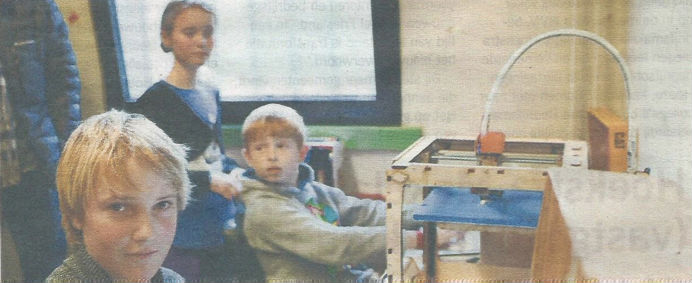
Obs De Zeester and vmbo-school De Krijtenburg at the island of Vlieland and obs De Wielen in Leeuwarden are forerunners during the next two years. They are investigating how a 3D printer can be used in their educational programme.
Drawing is something all children do in school, but 3D-drawing is new. Three schools in Friesland will be working on a teaching method involving a 3D printer in the coming two years, together with designers from House of Design. Earlier this month, they showed their progress at DesignXPO in the Blokhuispoort in Leeuwarden. “Look, first we make a design,” says Jelle van Randen of the vmbo-school. He is sitting at a computer in a former prison cell at the Blokhuispoort. In an expert way he describes to visitors how he creates a three dimensional object.
Also student Masja van Veen is able to explain perfectly what she has been doing at school. “The plan was to make a theatre together. We started by drawing a theatre.” She shows maps with sketches of a theatre room from all sides. The next step for the students was to make scale models. Meanwhile, the letters of the name of Jelle’s guest have appeared on his screen. “We have to connect them, otherwise the printer can’t handle it.” In the wink of an eye, he has shifted the capitals a touch askew to the left and a little slant to the right, forming a playful design. “There. Now we send the design to the printer.”
On the island of Vlieland, obs De Zeester and De Krijtenburg share the 3D printing machine. The youngest students use the programme Doodle 3D, the older ones use TinkerCad and Blender to make the designs. In England, Germany and Sweden, students are also taking part this Comenius project. “Comenius supports many international projects. This project was set up by De Krijtenburg and we were able to join them,” says teacher Cees. The participating schools work together with local design centres; in the Netherlands this is the role of House of Design.
Every six months the partners exchange their experiences at a conference in one of the participating countries, in order to develop a good teaching method. “We have to prevent the 3D printer from becoming a must-have gadget.” This is a realistic concern, for not only does the printer use (bio)plastic, it also prints in chocolate, says teacher Annemiek Middendorp. In the meantime, the machine is rattling on. Luca, one of Masha’s classmates: “Behind the back is the plastic. It is melted in the head at a temperature of 220 degrees Celsius.” A ventilator cools the substance down when it has been poured in the right shape.
Jelle has a quick deliberation with teacher Cees. “It can go from 40 to 100 percent now.” The base for the name label is firm enough, the top layer can be a litter thinner. This way it takes less time. “Look,” shows Jelle. “Only two minutes more now.” However neat it is to make a ‘name thingy’, a 3D printer can do lots more. Luca knows this as well. “I have an appointment with designer Tobias to make a remote controlled boat.”
www.3dvlie.com (in development)
(Source: Leeuwarder Courant)
Photo: LC
